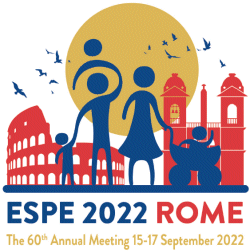
60th Annual ESPE (ESPE 2022)
Rome,
Italy
15 Sep 2022 - 17 Sep 2022
Poster Category 2
Bone, Growth Plate and Mineral Metabolism
hrp0095p2-28 | Bone, Growth Plate and Mineral Metabolism | ESPE2022
Longitudinal assessment of bone health index (BHI) as a measure of bone health in short-statured children before and during treatment with recombinant growth hormone
Holzapfel Lukas , Bettendorf Markus , Rabe Michael , Mittnacht Janna , Choukair Daniela , Schenk Jens-Peter
hrp0095p2-29 | Bone, Growth Plate and Mineral Metabolism | ESPE2022
Benign Family Hypercalcemia: A Case Report
Derya Buluş Ayşe , Yasartekin Yüksel
hrp0095p2-30 | Bone, Growth Plate and Mineral Metabolism | ESPE2022
Long QT revealing hypoparathyroidism in a B thalassemic major
Khensal Sabrina , Bouhelassa Amina , Benmohammed Karima , Nouri Nassim
hrp0095p2-31 | Bone, Growth Plate and Mineral Metabolism | ESPE2022
Short Stature and Single Central Incisor of The Upper Maxillar: Pathogenic Variant in The SHH Gene
Dominguez-Riscart Jesus , Arellano-Ruiz Paola , Garcia-Zarzuela Ana , Modamio-Høybjør Silvia , M Lechuga-Sancho Alfonso
hrp0095p2-32 | Bone, Growth Plate and Mineral Metabolism | ESPE2022
A novel pathogenic variant in PLS3 causing severe osteoporosis and vertebral fractures in an adolescent
García-Zarzuela Ana , Domínguez-Riscart Jesús , Paola Arellano-Ruiz , Carmen Rodríguez-Barrios , Silvia Modamio-Høybjør , Mª Lechuga-Sancho Alfonso
hrp0095p2-33 | Bone, Growth Plate and Mineral Metabolism | ESPE2022
Maternal Vitamin D deficiency leading to Rickets, Cardiomegaly and Unusual Metabolic Acidosis in a Term Infant: A Case Report
Warnasuriya Dhanushika , Liyanage Upeksha , Wickramarathne Isuru , Gunathilaka Ganganath , Kariyawasam Prathibha , Suntheresan Jananie
hrp0095p2-34 | Bone, Growth Plate and Mineral Metabolism | ESPE2022
Optimal 25-OH-Vitamin D level in children derived from metabolic parameters
Gillis David , Hefter Ari , Edri Edri Shalom , Strich David
hrp0095p2-35 | Bone, Growth Plate and Mineral Metabolism | ESPE2022
Parathyroid Hormone and Its Relationship to Calcium, Magnesium, and Phosphate in Children age 2 – 5 years old with Abnormal Levels of Vitamin D
Novina Novina , Bhakti Pulungan Aman , Dias Ismiarto Yoyos , Setiabudiawan Budi
hrp0095p2-36 | Bone, Growth Plate and Mineral Metabolism | ESPE2022
A Novel Variant of PHEX in a Korean Family with X-linked Hypophosphatemic Rickets
Kim Sejin , Kim Sungsoo , Kim Namhee
hrp0095p2-37 | Bone, Growth Plate and Mineral Metabolism | ESPE2022
A rare case of childhood hypophosphatasia presenting with fibrous dysplasia
Jeon Jaesung , Lee Jun , Young Yoon Ju , Kun Cheon Chong
hrp0095p2-38 | Bone, Growth Plate and Mineral Metabolism | ESPE2022
Is Platinum-Based Chemotherapy resulted Hypomagnesemia in a Girl with Osteosarcoma? A Case Report
Novina Novina , Aprilianti Dea , Faisal Faisal , Melani Sari Nur , Suryawan Nur , Susanah Susi , Milanti Dewi Mia , Hawani Dewi , Solek Purboyo , Amalia Risan Nelly
hrp0095p2-39 | Bone, Growth Plate and Mineral Metabolism | ESPE2022
An anomalous gait
Lanzafame Ruggero , Pitea Marco , Sala Elisa , Del Barba Paolo , Pia Guarneri Maria , Balzano Emanuela , Barera Graziano
hrp0095p2-40 | Bone, Growth Plate and Mineral Metabolism | ESPE2022
Overlooking hypoparatahyroidism in an 11-year-old boy patient with CHARGE syndrome
Sasaki Fusako , Kojima Kanako , Sasaoka Daiki , Koga Nobuhiko , Yatsuga Shuichi , Nagamitsu Shinichiro
hrp0095p2-41 | Bone, Growth Plate and Mineral Metabolism | ESPE2022
A Case Of Pseudohypoparathyoidism with an Unusual Presentation.
Adawy Mona , Hussein Yara , Chafee Karim , Kenawy Amin Asmaa
hrp0095p2-42 | Bone, Growth Plate and Mineral Metabolism | ESPE2022
Decreased Vitamin D Levels in The Pediatric Population After Covid-19 Lockdown
Pausilli Romina , Gaudino Rossella , Antoniazzi Franco , Cavarzere Paolo
hrp0095p2-43 | Bone, Growth Plate and Mineral Metabolism | ESPE2022
Clinical-molecular assistance pathway for primary bone fragility: a pediatric monocentric experience
Tessaris Daniele , Gavello Federica , Bonino Elisa , Tuli Gerdi , Matarazzo Patrizia , Deaglio Silvia , de Sanctis Luisa
hrp0095p2-44 | Bone, Growth Plate and Mineral Metabolism | ESPE2022
The changes of body composition in children with obesity
Waaks-Stępień Bogdan , Mikhno Hanna , Malastseva Lizaveta
hrp0095p2-45 | Bone, Growth Plate and Mineral Metabolism | ESPE2022
Adult weight and BMI associate with higher bone mineral density in the lumbar spine and femoral neck in young adults born preterm in the surfactant era
Bruun Ella , Pätsi Pauli , Björkman Krista , Leskinen Markku , Tulppo Mikko , Kulmala Petri , Valkama Marita , Ojaniemi Marja
hrp0095p2-46 | Bone, Growth Plate and Mineral Metabolism | ESPE2022
Successful treatment with zoledronic acid of a 13-year-old boy with corticosteroid-induced osteoporosis after hematopoietic stem cell transplantation
Athina Vlachopapadopoulou Elpis , Bonataki Myrto , Doulgeraki Artemis , Polyzois Giorgos , Paisiou Anna , Goussetis Eugenios , Peristeri Ioulia , Michalacos Stefanos
hrp0095p2-47 | Bone, Growth Plate and Mineral Metabolism | ESPE2022
Severe hypophosphatemia in a girl with vitamin D-dependent rickets type I: a case report
Menichetti Sofia , Ferrari Marta , Stagi Stefano
hrp0095p2-48 | Bone, Growth Plate and Mineral Metabolism | ESPE2022
An Unusual Case of Rickets and Anemia Due To Severe Nutritional Deficiency in A Child of Non-Caucasian Ethnicity
Urbano Flavia , Chiarito Mariangela , Moscogiuri Luigi , Felicia Faienza Maria



